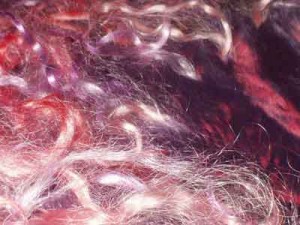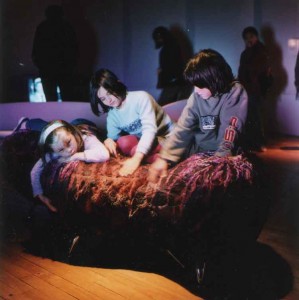Tactile/ We are covered in approximately1.6 square metres of skin that protects us from disease, chemicals and radiation, regulates body temperature, synthesises vitamins, repairs DNA, heals cuts and bruises, and keeps the mozzies out. Skin is covered in hair that mainly signals gender, age and identity in us humans, and also provides extra warmth for many other animals. As well as protecting us, skin also connects us to the world. You shiver as you jump into the cold surf, enjoy the warmth of the sun on your back, and feel the texture of grains of sand. Skin is a two way street. When you touch things you are simultaneously touched by them. We touch out of curiosity, to explore material, shape, weight, temperature, softness and things that can’t be known by looking or listening alone. We touch each other to communicate, to reassure, to direct attention, to find where it hurts, and to check for a high temperature. We enjoy being stroked and touch is an important part of affection.
The sense of touch comes from thermal, mechanical, chemical and electrical sensors at different depths in the skin and muscles that connect through the central nervous system to the brain. At the same time there are different nerves that connect from the brain to veins, muscles and skin in the same region. Some neurons respond only to stroking in a particular direction, while others respond to stroking at a specific frequency. Areas of the skin with more nerve endings, such as fingertips, lips and genitals, take up more space in the brain. Discontinuities in the layout of processing regions in the brain, such as the genitals below the feet, and the thumb next to the face, have been explained by the physical proximity of these sites in the womb when touch is developing as our first sense.
/interface/
The mouse and keyboard provide some degree of touch feedback in computer interfaces. Game controllers include rumble packs that vibrate when you shoot or hit a bump in the road. Probably the most common touch-based interface is the silent mode on a mobile phone. New interfaces for musical expression are being developed using sensors for pressure, proximity, bend, acceleration, position, heat, radiation and vibration.
In 2000 I directed the installation of a large 6m x 3m touch interface to the Welcome Space in the Gallery of First Australians at the National Museum of Australia. The carpet underlay in the space was wired with piezo cables that transduce force and vibration into electrical signals. The footsteps of people walking through the Welcome Space cause graphical and audio effects in the life size video projections around them. Like nerves in the skin, the sensitivity adapts to changes in the level of stimulation caused by smaller or larger groups.
My next experiment with touch interfaces integrated tactile input and output in the same place, and explored touch as a means to give the feeling of life and character to an inanimate object. ZiZi the Affectionate Couch growls when you sit on her, purrs when you stroke her fur, and mews for attention if left alone. Her sensory system consists of a motion detector wired to a microprocessor that activates nine vibrating devices under her fur. ZiZi was inspired by the scene in the movie Barbarella Queen of the Galaxy where Barbarella pilots the space ship using fluffy tactile interfaces while reclining on a fluffy flokati rug that suggests that technologies of the future will move beyond mass produced plastic and metal and screens to be more biological, organic, behavioural, emotional, psychological, gestural, and allow more subtle non-verbal modes of human interaction. A Sony Aibo robot dog responds to their owners words and actions yet fail to generate feelings of affection because you can’t cuddle or stroke something that feels like an appliance. Tactility gives ZiZi character and non-verbal emotional qualities. During an exhibition of ZiZi I overheard “who needs a boyfriend if you have one of these”. A teacher wrote that there was a marked improvement in the social interactions in her class of autistic children when they were playing together with the tactile responses of ZiZi.
/Textile
Smart fabrics have thermal, mechanical, chemical and electrical sensors that can measure aspects of the wearer, their activities, or the external world. These sensors are usually connected to a central processing unit (CPU) through an electrical wiring system. Smart fabrics can communicate through colour changes, lights, sounds, telecommunications and even movement. Like skin, clothing protects us from disease, chemicals, radiation, and physical abrasions. It insulates against the cold, and helps regulate body temperature. If we carry the analogy with skin further then one day a reSkin may synthesise vitamins, repair DNA and heal physical cuts and bruises. The
next generation in wound management products will move from wound repair to stimulation of wound healing. Research in this direction already underway at the CSIRO in Advanced fibrous materials research led by Robin Cranston. Some platform technologies being studied include “shear thickening” materials that thicken on impact to protect the wearer, “phase change” materials that moderate temperature in extreme conditions and sensors able to determine changes in physical and biophysical body condition.
 Currently there is a gap in the flow of information between the wearer and their clothing, especially in the case of wearable technologies. A touch interface could bridge the gap between the nerve endings in the skin and the sensors in a smart fabric, enabling a bilateral flow between the human nervous system and the extra sensing and communications in a wearable technology system. This coupling of skin to tactile interface puts the brain of the wearer in contact with external sensors and positions them as the “smart” part of the system.
Currently there is a gap in the flow of information between the wearer and their clothing, especially in the case of wearable technologies. A touch interface could bridge the gap between the nerve endings in the skin and the sensors in a smart fabric, enabling a bilateral flow between the human nervous system and the extra sensing and communications in a wearable technology system. This coupling of skin to tactile interface puts the brain of the wearer in contact with external sensors and positions them as the “smart” part of the system.
Rather than being analogous with skin, perhaps wearables are more analogous with an outer covering of hair or fur. A reFur would be more about communicating the identity of the wearer than enhanced awareness. Maybe a tactile reFur could provide affection, companionship and comfort, and have a character and life of its own.
Stephen Barrass
Stephen Barrass is a researcher in the School of Creative Communication at the University of Canberra. His interests include biometric interfaces, sonification, generative art and new media.
 This work is licensed under a Creative Commons Attribution-NonCommercial-ShareAlike 2.5 Australia.
This work is licensed under a Creative Commons Attribution-NonCommercial-ShareAlike 2.5 Australia.







